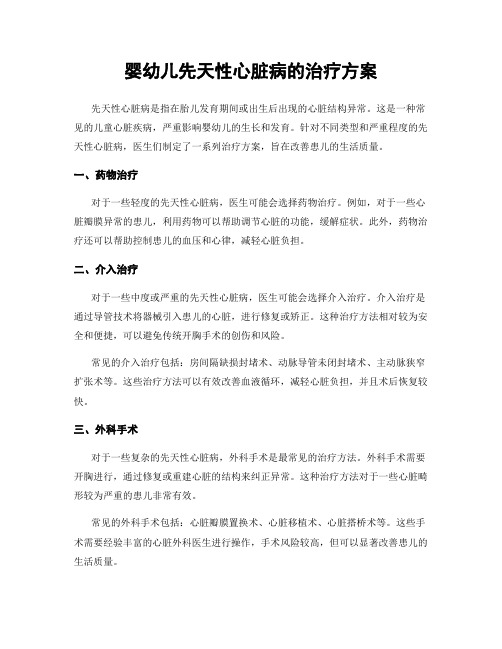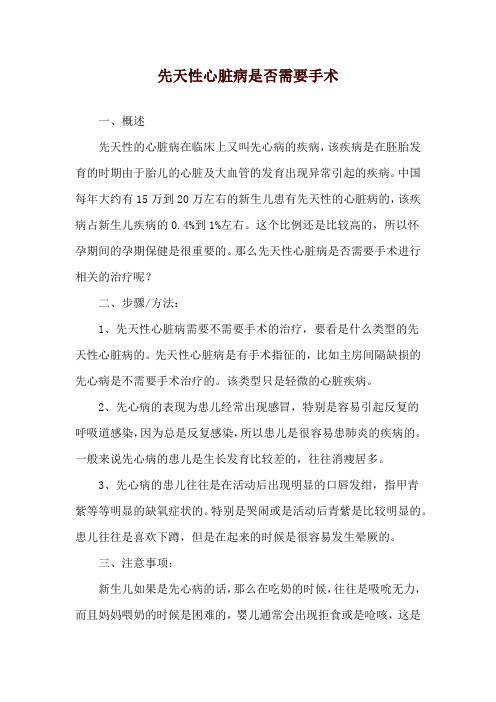先心病(30p)
先天性心脏病的原因及治疗方法

先天性心脏病的原因及治疗方法导语:先天性心脏病是先天性畸形中最常见的一类,危害巨大,甚至导致死亡。
那么先天性心脏病的原因有哪些?本文为推荐相关文章,欢迎阅读。
先天性心脏病的原因及治疗方法先天性心脏病的原因1、胎儿发育的环境因素(1)感染,妊娠前三个月患病毒或细菌感染,尤其是风疹病毒,其次是柯萨奇病毒,其出生的婴儿先天性心脏病的发病率较高。
(2)其它:如羊膜的病变,胎儿受压,妊娠早期先兆流产,母体营养不良、糖尿病、苯酮尿、高血钙,放射线和细胞毒性药物在妊娠早期的应用,母亲年龄过大等均有使胎儿发生先天性心脏病的可能。
2、遗传因素先天性心脏病具有一定程度的家族发病趋势,可能因父母生殖细胞、染色体畸变所引起的。
遗传学研究认为,多数的先天性心脏病是由多个基因与环境因素相互作用所形成。
3、其它有些先天性心脏病在高原地区较多,有些先天性心脏病有显著的男女性别间发病差异,说明出生地海拔高度和性别也与本病的发生有关。
在先天性心脏病患者中,能查到病因的是极少数,但加强对孕妇的保健,特别是在妊娠早期积极预防风疹、流感等风疹病毒性疾病和避免与发病有关的一切因素,对预防先天性心脏病具有积极意义。
先天性心脏病治疗方法1.一般先天性心脏病中仅有少数类型的先天性心脏病可以自然恢复,有的则随着年龄的增大,并发症会渐渐增多,病情也逐渐加重。
选择何种治疗方法以及选择正确的手术时机,主要取决于先天性心脏畸形的范围及程度。
简单而轻微的畸形如房间隔缺损、单纯肺动脉瓣狭窄,如缺损直径小,则对血流动力学无明显影响,可以终身不需任何治疗。
严重的先天性心脏病如完全性大动脉转位或左心发育不良综合征,在出生后必须立即手术,否则患儿将无法生存。
2.保守观察的先天性心脏病病例。
(1)直径较小、无肺高压倾向的继发孔房缺者,可观察到3~5岁再手术;(2)直径小于4毫米的膜部室间隔缺损,对心功能影响轻,并且有自动闭合的可能,所以也可以观察到3~5岁,如室缺仍未能闭合则应考虑手术治疗。
(医学课件)先天性心脏病

先天性心脏病contents •先天性心脏病概述•先天性心脏病的诊断•先天性心脏病的治疗•先天性心脏病预防•先天性心脏病研究展望目录01先天性心脏病概述先天性心脏病(CHD)是一种胎儿心脏结构或大血管发育异常的疾病,多为遗传因素所致。
定义根据心脏结构和功能异常的严重程度,先天性心脏病可分为简单型和复杂型,其中复杂型先天性心脏病包括法洛四联症、大动脉转位、肺动脉瓣狭窄等。
分类定义与分类发病率先天性心脏病在活产新生儿中的发病率约为0.6%-1%,其中复杂型先天性心脏病的发病率较低。
死亡率未治疗的先天性心脏病患儿的死亡率很高,复杂型先天性心脏病的死亡率更高。
随着医学技术的进步,先天性心脏病的治愈率逐渐提高。
发病率和死亡率1致病因素23先天性心脏病有家族聚集现象,与染色体异常有关,如21-三体综合征、威廉姆斯综合征等。
遗传因素环境因素如孕妇感染风疹病毒、孕期接触放射线、药物等,也可能导致胎儿心脏发育异常。
环境因素高龄孕妇、既往生育过异常胎儿、家族遗传史等为先天性心脏病的易发因素。
其他因素03其他病理生理变化先天性心脏病患儿还可能发生心律失常、心肌肥厚、心肌缺血等病理生理变化。
病理生理01血流动力学改变先天性心脏病患儿的血流动力学改变取决于心脏结构和功能异常的类型。
02肺动脉高压长期左心房压力升高可导致肺动脉高压,引起肺循环淤血和右心衰竭症状。
02先天性心脏病的诊断详细询问家族史和孕产史了解先天性心脏病的发病风险,是否有遗传倾向或其他先天性疾病。
临床诊断观察症状表现先天性心脏病的症状因类型而异,常见的包括心悸、气促、青紫、乏力、发育迟缓等。
体格检查观察患者体征,如血压、心率、心音等,初步评估心脏病变程度。
心电图检查通过心电图检查,观察心脏电生理活动是否正常。
动态心电图监测有助于评估先天性心脏病患者的心脏功能及预测心律失常等并发症的风险。
心电图诊断影像学诊断X线胸片01观察心脏轮廓、大小及肺部淤血情况。
超声心动图02直接观察心脏结构及功能,如瓣膜关闭不全、心室肥厚、心包积液等。
什么是先天性心脏病

什么是先天性心脏病众所周知,心脏病史危害我们人体生命的一种常见性致命疾病,这种疾病无论是中年人还是老年人,这种疾病的危害都不在无时无刻的威逼着他们。
尤其是先天心脏病,使得为未诞生的婴儿刚一见到这个世界就有夭折的危急。
今日我们就来看一下这种疾病。
先天性心脏病是先天性畸形中最常见的一类,约占各种先天畸形的28%,指在胚胎发育时期由于心脏及大血管的形成障碍或发育特别而引起的解剖结构特别,或诞生后应自动关闭的通道未能闭合(在胎儿属正常)的情形。
先天性心脏病发病率不容小视,占诞生活婴的0.4%~1%,这意味着我国每年新增先天性心脏病患者15~20万。
先天性心脏病谱系特殊广,包括上百种详细分型,有些患者可以同时合并多种畸形,症状千差万别,最轻者可以终身无症状,重者诞生即消失严峻症状如缺氧、休克甚至夭折。
依据血液动力学结合病理生理变化,先天性心脏病可分为发绀型或者非发绀型,也可依据有无分流分为三类:无分流类(如肺动脉狭窄、主动脉缩窄)、左至右分流类(如房间隔缺损、室间隔缺损、动脉导管未闭)和右至左分流(如法洛氏四联症、大血管错位)类。
少部分先天性心脏病在5岁前有自愈的机会,另外有少部分患者畸形稍微、对循环功能无明显影响,而无需任何治疗,但大多数患者需手术治疗校正畸形。
随着医学技术的飞速进展,手术效果已经极大提高,目前多数患者如准时手术治疗,可以和正常人一样恢复正常,生长发育不受影响,并能胜任一般的工作、学习和生活的需要。
病因一般认为妊娠早期(5~8周)是胎儿心脏发育最重要的时期,先天性心脏病发病缘由许多,遗传因素仅占8%左右,而占92%的绝大多数则为环境因素造成,如妇女妊娠时服用药物、感染病毒、环境污染、射线辐射等都会使胎儿心脏发育特别。
尤其妊娠前3个月感染风疹病毒,会使孩子患上先天性心脏病的风险急剧增加。
临床表现先天性心脏病的种类许多,其临床表现主要取决于畸形的大小和简单程度。
简单而严峻的畸形在诞生后不久即可消失严峻症状,甚至危及生命。
先心病症状有哪些

先心病症状有哪些
先心病还有一个名字就是先天性心脏病,先心病在胎儿时期因为多种因素造成的一种疾病,患者较轻的时候没有什么症状表现出来,只有在进行身体检查的时候才会被发现,一般患有这个疾病的时候在婴儿时期就会有症状出现,随着年纪的增长,病症也会变得严重,会给患者造成严重的后果。
★先心病症状有:
★1、心衰:
胸闷、心前区疼痛、心慌,特别在活动以后,这些症状更明显。
患儿面色苍白,憋气,呼吸困难和心动过速,心率每分钟可达160—190次,血压常偏低。
可听到奔马律。
★2、紫绀:
在鼻尖、口唇、指(趾)甲床、眼结膜等处见皮肤粘膜青紫色。
★3、发育迟缓、智力低下:
在紫绀出现的同时,患儿生长发育迟缓,智力低下,当吃奶或哭闹后可发生呼吸困难,严重者有神志丧失、抽搐。
★4、杵状指(趾)和红细胞增多症:
肢体末端慢性缺氧、代谢障碍、中毒性损伤。
手指或足趾末端软组织增生、肥厚、呈杵状膨大,指甲纵横径均过渡弯如鹦鹉嘴状,这是慢性缺氧所致。
★5、蹲踞:
婴幼儿期抱着时双腿不伸直,而喜屈曲在大人的腹部,坐着时喜将脚抬到凳面上,站着时下肢保持弯曲的姿势。
年长儿走路时,常常因有脑缺氧感觉,走一段时间就蹲下来两膝紧贴胸部休息片刻,医学上称为蹲踞现象。
★6、其它:
胸痛、晕厥、猝死。
部分人有体循环方面的症状,例如排汗量异常,大大超出正常人的量。
先天性心脏病教学课件ppt

定义与分类
发病原因
CHD的发生与遗传因素、环境因素等多种因素有关,其中遗传因素包括染色体畸变、基因突变等,环境因素包括母体感染、药物滥用等。
流行病学
CHD是一种常见的先天性疾病,其发病率较高,尤其在早产儿、低出生体重儿等高危人群中更为常见。
药物治疗
根据医生建议,按时按量服用药物,控制病情进展。
心理支持
关注患儿及家庭的心理健康,提供必要的心理支持和辅导。
定期随访
定期到医院进行随访检查,及时发现并处理可能出现的问题。
06
先天性心脏病的教学建议
针对医学生的教学策略
制定明确的教学目标
明确教学目标,确保医学生能够全面掌握先天性心脏病的基本知识、诊断方法、治疗方法以及护理措施。
发病原因与流行病学
CHD的诊断主要依靠临床表现和影像学检查,如心电图、超声心动图、心脏导管检查等。
诊断
CHD的治疗方法包括药物治疗、介入治疗和手术治疗等,其中手术治疗是根治CHD的主要方法。目前,随着医疗技术的不断发展,手术治疗的疗效和安全性得到了显著提高。
治疗
诊断与治疗现状
02
先天性心脏病的症状与体征
传统开胸手术
通过小切口或导管进行手术,创伤小,恢复快。
微创手术
利用机器人技术进行更精确的手术操作。
机器人辅助手术
通过导管在血管内进行修复或植入医疗器械。
介入治疗
心脏移植
干细胞治疗
对于严重心脏病患者,可以进行心脏移植。
新兴的治疗方法,用于修复受损的心肌。
03
其他治疗手段
先天性心脏病的科普知识PPT课件

先天性心脏病的原因
母体在孕期过量使用药物或酒 精也可能增加先天性心脏病的 风险。
常见的先天性 心脏病症状
常见的先天性心脏病症状
不同类型的先天性心脏病可能 具有不同的症状。 婴儿可能出现呼吸困难、发紫 、皮肤颜色苍白等症状。
常见的先天性心脏病症状
幼儿和儿童可能出现体力活动 时呼吸加快、乏力、心悸等症 状。
如何诊断先天 性心脏病?
如何诊断先天性心脏病?
先天性心脏病的诊断通常通过体格 检查和心电图进行。 医生可能会使用超声心动图或其他 影像学检查来评估心脏结构。
如何诊断先天性心脏病?
有时需要进行心导管检查或心 脏磁共振成像以获取更详细的 信息。
治疗先天性心 脏病
治疗先天性心脏病
治疗方法根据先天性心脏病的 类型和严重程度而异。 轻度先天性心脏病可能无需治 疗,但需要定期随访。
治疗先天性心脏病
一些病例可能需要手术或介入 治疗来修复心脏结构。
预防先天性心 脏病
预防先天性心脏病
无法完全预防先天性心脏病,但可 以采取措施降低风险。 孕期健康管理和规律的产前检查非 常重要。
预防先天性心脏病
保持良好的孕期营养和避免有 害物质的接触也很重要。
总结
总结
先天性心脏病是一种在胚胎发 育阶段出现的心脏结构异常。 它可能涉及不同部位的心脏组 织。
什么是先天性 心脏病?
什么是先天性心ቤተ መጻሕፍቲ ባይዱ病?
先天性心脏病是指在胎儿发育 阶段,心脏结构发生异常。 可能涉及心脏的心脏壁、瓣膜 、动脉、静脉等部分。
什么是先天性心脏病?
先天性心脏病分为有缺陷和无 缺陷两种类型。
先天性心脏病 的原因
先天性心脏病的原因
先天性心脏病的确切原因尚不清楚 。 遗传、环境因素和母体疾病可能是 发生先天性心脏病的风险因素。
先天性心脏病

先天性心脏病先天性心脏病先天性心脏病(congenital heart disease,CHD)是指胎儿时期心脏血管发育异常而致的心血管畸形,是小儿最常见的心脏病。
在1000个出生存活的婴儿中,发生该病者约6-8名。
中国每年大约有15万新生婴儿患有各种类型的先天性心脏病。
先天性心脏病是先天性畸形中最常见的一类,约占各种先天畸形的28%,指在胚胎发育时期由于心脏及大血管的形成障碍或发育异常而引起的解剖结构异常,或出生后应自动关闭的通道未能闭合(在胎儿属正常)的情形。
先天性心脏病发病率不容小视,占出生活婴的0.4%~1%,这意味着我国每年新增先天性心脏病患者15~20万。
先天性心脏病谱系特别广,包括上百种具体分型,有些患者可以同时合并多种畸形,症状千差万别,最轻者可以终身无症状,重者出生即出现严重症状如缺氧、休克甚至夭折。
根据血液动力学结合病理生理变化,先天性心脏病可分为发绀型或者非发绀型,也可根据有无分流分为三类:无分流类(如肺动脉狭窄、主动脉缩窄)、左至右分流类(如房间隔缺损、室间隔缺损、动脉导管未闭)和右至左分流(如法洛氏四联症、大血管错位)类。
少部分先天性心脏病在5岁前有自愈的机会,另外有少部分患者畸形轻微、对循环功能无明显影响,而无需任何治疗,但大多数患者需手术治疗校正畸形。
随着医学技术的飞速发展,手术效果已经极大提高,目前多数患者如及时手术治疗,可以和正常人一样恢复正常,生长发育不受影响,并能胜任普通的工作、学习和生活的需要。
先天性心脏病的原因1、胎儿发育的环境因素:(1)感染,妊娠前三个月患病毒或细菌感染,尤其是风疹病毒,其次是柯萨奇病毒,其出生的婴儿先天性心脏病的发病率较高。
(2)其它:如羊膜的病变,胎儿受压,妊娠早期先兆流产,母体营养不良、糖尿病、苯酮尿、高血钙,放射线和细胞毒性药物在妊娠早期的应用,母亲年龄过大等均有使胎儿发生先天性心脏病的可能。
先天性心脏病是胎儿时期心脏血管发生异常所致的心血管畸形,或者是应该自动关闭的通道没有闭合(在胎儿属正常)的心脏,是小儿最常见的心脏病。
先天性心脏病ppt精品医学课件

QRS≥0.12秒
P-R<0.12秒
T波倒置
Delta波
WPW综合征Delta波的心电图特征
本图显示:窦房结的冲动形成以后同时沿着正常房室传导系统及副束下传心室,由于副束传导速度较快,冲动由副束传导优先进入心室,使部分心室肌预先激动,心电图上出现Delta波(右图绿色部分)
本例心电图,P波消失,R-R不等,图中QRS波宽大畸形,起始部有粗钝,时限0.15秒,心室率极快达200次/分。T波呈继发性改变。提示:预激综合征伴房颤
Brugada综合征的分子遗传学
Brugada综合征是一种编码心脏离子通道基因突变导致的常染色体显性遗传性疾病——原发性心电疾病: 心电图具有特征性的 “三联征”: 类右束支阻滞; 右胸导联(V1-V3) ST呈下斜形或马鞍形抬高、T波倒置; 临床常因室颤或多形性室速引起反复晕厥、甚至猝死。
Brugada综合征分型
表1 Brugada综合征各类型特征
I型
II型
III型
J波幅度
≥2mm
≥2mm
≥2mm
T波
负向
正向或双向
正向
ST-T形态
下斜形
马鞍状
马鞍状
ST段终末部分
逐渐下斜
抬高≥1mm
上移<1mm
注: 3种类型主要表现在右胸V1-V3导联,常在多个导联同时出现,并以V2导联最明显, 少数情况下V4导联亦可出现Brugada波
右位心
法络四联症:肺动脉狭窄、室间隔缺损、主动脉骑跨、右心室肥厚。 法络三联症:肺动脉狭窄、心房间隔缺损(或卵圆孔开放)和右心室肥厚
先天性心脏病的科普知识

先天性心脏病的诊断与治疗
先天性心脏病的诊断与治疗
先天性心脏病的诊断通常包括身体检查 、心电图和超声心动图等 治疗先天性心脏病的方法包括药物治疗 、手术和介入治疗等
先天性心脏病的预防与控制
先天性心脏病的预防与控制
计划生育,避免孕妇感染影响胎儿发育 孕期定期产检,及时发现并处理可能存 在的问题
先天性心脏病的预防与控制
先天性心脏病的科普知 识
目录 什么是先天性心脏病 先天性心脏病的分类 先天性心脏病的症状 先天性心脏病的诊断与治疗 先天性心脏病的预防与控制 先天性心脏病对患者的影响 先天性心脏病的研究与进展 总结
பைடு நூலகம்
什么是先天性心脏病
什么是先天性心脏病
先天性心脏病是指在出生前或出生后出 现的心脏结构异常或功能异常 先天性心脏病可以包括心脏的结构缺陷 、心脏中的血液流量异常、心脏壁厚度 变化等
总结
总结
先天性心脏病是一种在出生前或出生后 就存在的心脏疾病 了解先天性心脏病的知识,有助于及时 识别并治疗潜在的心脏问题,提高患者 的生活质量
谢谢您的观赏 聆听
先天性心脏病的分类
先天性心脏病的分类
根据病变的性质和严重程度不同,先天 性心脏病可以分为简单型和复杂型 常见的先天性心脏病有房间隔缺损、室 间隔缺损、动脉导管未闭等
先天性心脏病的症状
先天性心脏病的症状
不同类型的先天性心脏病可能表现出不 同的症状 一些常见的症状包括呼吸困难、发绀、 体重增长缓慢等
提前定期体检,早期发现并治疗可能存 在的心脏问题
先天性心脏病对患者的影响
先天性心脏病对患者的影响
先天性心脏病可能对患者的生活质量和 心理健康产生影响 患者和家人需要了解对先天性心脏病的 认识,积极配合医生的治疗
先天性心脏病中文解说

先天性心脏病先天性心血管病是先天性畸形中最常见的一类。
轻者无症状,查体时发现,重者可有活动后呼吸困难、紫绀、晕厥等,年长儿可有生长发育迟缓。
症状有无与表现还与疾病类型和有无并发症有关。
根据血液动力学结合病理生理变化,可发为三类:一、无分流类。
二、左至右分流类。
三、右至左分流类。
疾病简介在人胚胎发育时期(怀孕初期2-3个月内),由于心脏及大血管的形成障碍而引起的局部解剖结构异常,或出生后应自动关闭的通道未能闭合(在胎儿属正常)的心脏,称为先天性心脏病。
除个别小室间隔缺损在5岁前有自愈的机会,绝大多数需手术治疗。
临床上以心功能不全、紫绀以及发育不良等为主要表现。
先天性心脏病是胎儿时期心脏血管发育异常所致的心血管畸形,是小儿最常见的心脏病。
其发病率约占出生婴儿的0.8%,其中60%于<1 岁死亡。
发病可能与遗传尤其是染色体易位与畸变、宫内感染、大剂量放射性接触和药物等因素有关。
随着心血管医学的快速发展,许多常见的先天性心脏病得到准确的诊断和合理的治疗,病死率已显著下降。
编辑本段分类传统分类方法主要根据血流动力学变化将先天性心脏病分为三组。
(1)无分流型(无青紫型)即心脏左右两侧或动静脉之间无异常通路和分流,不产生紫绀。
包括主动脉缩窄、肺动脉瓣狭窄、主动脉瓣狭窄以及肺动脉瓣狭窄、单纯性肺动脉扩张、原发性肺动脉高压等。
(2)左向右分流组(潜伏青紫型)此型有心脏左右两侧血流循环途径之间异常的通道。
早期由于心脏左半侧体循环的压力大于右半侧肺循环压力,所以平时血流从左向右分流而不出现青紫。
当啼哭、屏气或任何病理情况,致使肺动脉或右心室压力增高,并超过左心压力时,则可使血液自右向左分流而出现暂时性青紫。
如房间隔缺损、室间隔缺损、动脉导管未闭、主肺动脉隔缺损,以及主动脉窦动脉瘤破入右心或肺动脉等。
(3)右向左分流组(青紫型)该组所包括的畸形也构成了左右两侧心血管腔内的异常交通。
右侧心血管腔内的静脉血,通过异常交通分流入左侧心血管腔,大量静脉血注入体循环,故可出现持续性青紫。
婴幼儿先天性心脏病的治疗方案

婴幼儿先天性心脏病的治疗方案先天性心脏病是指在胎儿发育期间或出生后出现的心脏结构异常。
这是一种常见的儿童心脏疾病,严重影响婴幼儿的生长和发育。
针对不同类型和严重程度的先天性心脏病,医生们制定了一系列治疗方案,旨在改善患儿的生活质量。
一、药物治疗对于一些轻度的先天性心脏病,医生可能会选择药物治疗。
例如,对于一些心脏瓣膜异常的患儿,利用药物可以帮助调节心脏的功能,缓解症状。
此外,药物治疗还可以帮助控制患儿的血压和心律,减轻心脏负担。
二、介入治疗对于一些中度或严重的先天性心脏病,医生可能会选择介入治疗。
介入治疗是通过导管技术将器械引入患儿的心脏,进行修复或矫正。
这种治疗方法相对较为安全和便捷,可以避免传统开胸手术的创伤和风险。
常见的介入治疗包括:房间隔缺损封堵术、动脉导管未闭封堵术、主动脉狭窄扩张术等。
这些治疗方法可以有效改善血液循环,减轻心脏负担,并且术后恢复较快。
三、外科手术对于一些复杂的先天性心脏病,外科手术是最常见的治疗方法。
外科手术需要开胸进行,通过修复或重建心脏的结构来纠正异常。
这种治疗方法对于一些心脏畸形较为严重的患儿非常有效。
常见的外科手术包括:心脏瓣膜置换术、心脏移植术、心脏搭桥术等。
这些手术需要经验丰富的心脏外科医生进行操作,手术风险较高,但可以显著改善患儿的生活质量。
四、心脏康复无论是药物治疗、介入治疗还是外科手术,心脏康复都是治疗先天性心脏病的重要环节。
心脏康复旨在通过运动、营养和心理支持等综合措施,帮助患儿恢复心脏功能,提高生活质量。
在心脏康复过程中,医生会制定个性化的运动计划,根据患儿的年龄和病情,逐步增加运动强度。
此外,合理的饮食和营养摄入也是心脏康复的重要内容,有助于患儿的生长发育。
同时,心理支持也是不可或缺的。
婴幼儿的心脏病治疗需要家庭的支持和关爱,医生和心理咨询师可以通过心理辅导和心理疏导,帮助患儿和家人应对治疗过程中的压力和情绪困扰。
总结起来,婴幼儿先天性心脏病的治疗方案是多样化的,根据患儿的具体情况选择合适的治疗方法。
什么是先天性心脏病

什么是先天性心脏病众所周知,心脏病史危害我们人体生命的一种常见性致命疾病,这种疾病无论是中年人还是老年人,这种疾病的危害都不在无时无刻的威胁着他们。
尤其是先天心脏病,使得为未出生的婴儿刚一见到这个世界就有夭折的危险。
今天我们就来看一下这种疾病。
先天性心脏病是先天性畸形中最常见的一类,约占各种先天畸形的28%,指在胚胎发育时期由于心脏及大血管的形成障碍或发育异常而引起的解剖结构异常,或出生后应自动关闭的通道未能闭合(在胎儿属正常)的情形。
先天性心脏病发病率不容小视,占出生活婴的0.4%~1%,这意味着我国每年新增先天性心脏病患者15~20万。
先天性心脏病谱系特别广,包括上百种具体分型,有些患者可以同时合并多种畸形,症状千差万别,最轻者可以终身无症状,重者出生即出现严重症状如缺氧、休克甚至夭折。
根据血液动力学结合病理生理变化,先天性心脏病可分为发绀型或者非发绀型,也可根据有无分流分为三类:无分流类(如肺动脉狭窄、主动脉缩窄)、左至右分流类(如房间隔缺损、室间隔缺损、动脉导管未闭)和右至左分流(如法洛氏四联症、大血管错位)类。
少部分先天性心脏病在5岁前有自愈的机会,另外有少部分患者畸形轻微、对循环功能无明显影响,而无需任何治疗,但大多数患者需手术治疗校正畸形。
随着医学技术的飞速发展,手术效果已经极大提高,目前多数患者如及时手术治疗,可以和正常人一样恢复正常,生长发育不受影响,并能胜任普通的工作、学习和生活的需要。
病因一般认为妊娠早期(5~8周)是胎儿心脏发育最重要的时期,先天性心脏病发病原因很多,遗传因素仅占8%左右,而占92%的绝大多数则为环境因素造成,如妇女妊娠时服用药物、感染病毒、环境污染、射线辐射等都会使胎儿心脏发育异常。
尤其妊娠前3个月感染风疹病毒,会使孩子患上先天性心脏病的风险急剧增加。
临床表现先天性心脏病的种类很多,其临床表现主要取决于畸形的大小和复杂程度。
复杂而严重的畸形在出生后不久即可出现严重症状,甚至危及生命。
先天性心脏病是否需要手术

先天性心脏病是否需要手术
一、概述
先天性的心脏病在临床上又叫先心病的疾病,该疾病是在胚胎发育的时期由于胎儿的心脏及大血管的发育出现异常引起的疾病。
中国每年大约有15万到20万左右的新生儿患有先天性的心脏病的,该疾病占新生儿疾病的0.4%到1%左右。
这个比例还是比较高的,所以怀
孕期间的孕期保健是很重要的。
那么先天性心脏病是否需要手术进行相关的治疗呢?
二、步骤/方法:
1、先天性心脏病需要不需要手术的治疗,要看是什么类型的先
天性心脏病的。
先天性心脏病是有手术指征的,比如主房间隔缺损的先心病是不需要手术治疗的。
该类型只是轻微的心脏疾病。
2、先心病的表现为患儿经常出现感冒,特别是容易引起反复的
呼吸道感染,因为总是反复感染,所以患儿是很容易患肺炎的疾病的。
一般来说先心病的患儿是生长发育比较差的,往往消瘦居多。
3、先心病的患儿往往是在活动后出现明显的口唇发绀,指甲青
紫等等明显的缺氧症状的。
特别是哭闹或是活动后青紫是比较明显的。
患儿往往是喜欢下蹲,但是在起来的时候是很容易发生晕厥的。
三、注意事项:
新生儿如果是先心病的话,那么在吃奶的时候,往往是吸吮无力,而且妈妈喂奶的时候是困难的,婴儿通常会出现拒食或是呛咳,这是
因为平时的呼吸是急促导致的。
先天性心脏病是什么原因造成的

先天性心脏病是什么原因造成的先天性心脏病是一种在出生时就存在的心脏结构或功能异常,给患儿和家庭带来了巨大的挑战和困扰。
要了解先天性心脏病,首先得弄清楚它的成因。
先天性心脏病的形成原因较为复杂,往往是多种因素相互作用的结果。
遗传因素在其中扮演着重要的角色。
如果家族中有先天性心脏病的病史,那么后代患上先天性心脏病的风险就会相应增加。
这可能是由于某些基因突变或染色体异常导致的。
比如,21 三体综合征(唐氏综合征)的患儿就常常伴有先天性心脏病。
在胚胎发育的过程中,任何干扰正常心脏发育的因素都可能导致先天性心脏病。
母亲在怀孕早期,尤其是怀孕的前 3 个月,如果受到病毒感染,如风疹病毒、巨细胞病毒、柯萨奇病毒等,可能会影响胎儿的心脏发育。
这些病毒可以通过胎盘进入胎儿体内,干扰细胞的正常分裂和分化,从而导致心脏结构的异常。
母亲在孕期的健康状况对胎儿心脏发育也至关重要。
如果母亲患有糖尿病,其血糖控制不佳时,胎儿发生先天性心脏病的几率会明显升高。
这是因为高血糖环境会影响胚胎的正常发育,包括心脏的发育。
同样,母亲患有甲状腺功能亢进或减退等内分泌疾病,也可能对胎儿心脏发育产生不利影响。
孕期的环境因素同样不容忽视。
母亲在怀孕期间接触到有害物质,如化学毒物、放射性物质等,都有可能增加胎儿患先天性心脏病的风险。
某些药物的使用,如抗癫痫药物、抗肿瘤药物等,如果在孕期不当使用,也可能对胎儿心脏发育造成损害。
除此之外,母亲在怀孕期间如果缺乏某些重要的营养物质,如叶酸,也可能与先天性心脏病的发生有关。
叶酸对于胎儿的神经系统和心血管系统的发育都非常重要。
缺乏叶酸可能导致神经管缺陷和心脏畸形。
胎儿自身的因素也可能导致先天性心脏病。
比如,胎儿在子宫内的位置异常,或者出现脐带绕颈等情况,导致胎儿的血液供应和氧气供应不足,也可能影响心脏的正常发育。
另外,高龄产妇也是先天性心脏病的一个高危因素。
随着年龄的增长,卵子的质量下降,染色体异常的风险增加,从而使得胎儿患上先天性心脏病的可能性增大。
先天性心脏病

先天性心脏病疾病简介:在人胚胎发育时期(怀孕初期2-3个月内),由于心脏及大血管的形成障碍而引起的局部解剖结构异常,或出生后应自动关闭的通道未能闭合(在胎儿属正常)的心脏,称为先天性心脏病。
除个别小室间隔缺损在5岁前有自愈的机会,绝大多数需手术治疗。
临床上以心功能不全、紫绀以及发育不良等为主要表现。
先天性心脏病是胎儿时期心脏血管发育异常所致的心血管畸形,是小儿最常见的心脏病。
其发病率约占出生婴儿的0.8%,其中60%于<1 岁死亡。
发病可能与遗传尤其是染色体易位与畸变、宫内感染、大剂量放射性接触和药物等因素有关。
随着心血管医学的快速发展,许多常见的先天性心脏病得到准确的诊断和合理的治疗,病死率已显著下降。
临床分型:(1)无分流型(无青紫型)(2)左向右分流组(潜伏青紫型)(3)右向左分流组(青紫型)遗传因素:先天性心脏病具有一定程度的家族发病趋势,可能因父母生殖细胞、染色体畸变所引起的。
遗传学研究认为,多数的先天性心脏病是由多个基因与环境因素相互作用所形成。
其它:有些先天性心脏病在高原地区较多,有些先天性心脏病有显著的男女性别间发病差异,说明出生地海拔高度和性别也与本病的发生有关。
在先天性心脏病患者中,能查到病因的是极少数,但加强对孕妇的保健,特别是在妊娠早期积极预防风疹、流感等风疹病毒性疾病和避免与发病有关的一切因素,对预防先天性心脏病具有积极意义。
临床症状:心衰:新生儿心衰被视为一种急症,通常大多数是由于患儿有较严重的心脏缺损。
其临床表现是由于肺循环、体循环充血,心输出量减少所致。
患儿面色苍白,憋气,呼吸困难和心动过速,心率每分钟可达160次-190次,血压常偏低。
可听到奔马律。
肝大,但外周水肿较少见。
紫绀:其产生是由于右向左分流而使动静脉血混合。
在鼻尖、口唇、指(趾)甲床最明显。
蹲踞:患有紫绀型先天性心脏病的患儿,特别是法乐氏四联症的患儿,常在活动后出现蹲踞体征,这样可增加体循环血管阻力从而减少心隔缺损产生的右向左分流,同时也增加静脉血回流到右心,从而改善肺血流。
- 1、下载文档前请自行甄别文档内容的完整性,平台不提供额外的编辑、内容补充、找答案等附加服务。
- 2、"仅部分预览"的文档,不可在线预览部分如存在完整性等问题,可反馈申请退款(可完整预览的文档不适用该条件!)。
- 3、如文档侵犯您的权益,请联系客服反馈,我们会尽快为您处理(人工客服工作时间:9:00-18:30)。
25-30 6-8 6-82 1-2 5-10
Atrial Septal Defect
Atrial Septal Defect
Three major types
Ostium secundum
most common In the middle of the septum in the region of the foramen
Defects can occur in both the membranous portion of the septum (most common) and the muscular portion
Ventricular Septal Defect
Ventricular Septal Defect
Three major types Small, hemodynamically
insignificant
Between 80% and 85% of all VSDs < 3 mm in diameter All close spontanously
50% by 2 years 90% by 6 years 10% during school years
ovale
Ostium primum
Low position Form of AV septal defect
Sinus venosus
Least common Positioed high in the atrial septum Frequently associated with PAPVR
Relative Frequency of Lesions
Ventricular septal defect Atrial septal defect (secundum) Patent ductus arteriosus Coarctation of aorta Tetralogy of Fallot Pulmonary valve stenosis Aortic valve stenosis Transposition of great arteries Hypoplastic left ventricle Hypoplastic right ventricle Truncus arteriosus Total anomalous pulm venous return Tricuspid atresia Double-outlet right ventricle Others
hypertension, may be followed until spontaneous closure occurs
Ventricular Septal Defect
Large VSDs with normal PVR
6-10 mm in diameter Usually requires surgery, otherwise… Will develop CHF and FTT by age 3-6
Most common category of congenital structural malformation
Commonly divided into noncyanotic (L R) and cyanotic (R L) categories based on direction of shunting
Previously surgical; now often closed interventionally
Atrial Septal Defect
Ventricular Septal Defect
Single most common congenital heart malformation, accounting for almost 30% of all CHD
Atrial Septal Defect
Treatment
Closure generally recommended when ratio of pulmonary to systemic blood flow (qP/qS) is > 2:1
Operation performed electively between ages 1 and 3 years
Muscular close sooner than membranous
Ventricular Septal Defect
Moderate VSDs
3-5 mm in diameter Least common group of children (3-5%) Without evidence of CHF or pulmonary
months
Ventricular Septal Defects
Clinical findings
Grade II-IV/VI, medium- to highpitched, harsh pansystolic murmur heard best at the left sternal border with radiation over the entire precordium
A Quick Tour of Congenital Heart Disease
Chris Longhurst, MD Wednesday, October 21, 2020
Introduction
Present in 0.8% of North American and European children
Ventricular Septal Defect
Treatment
Indicated for closure of a VSD associated
with CHF and FTT or pulmonary
hypertension Patients with cardiomegaly, poor growth,
